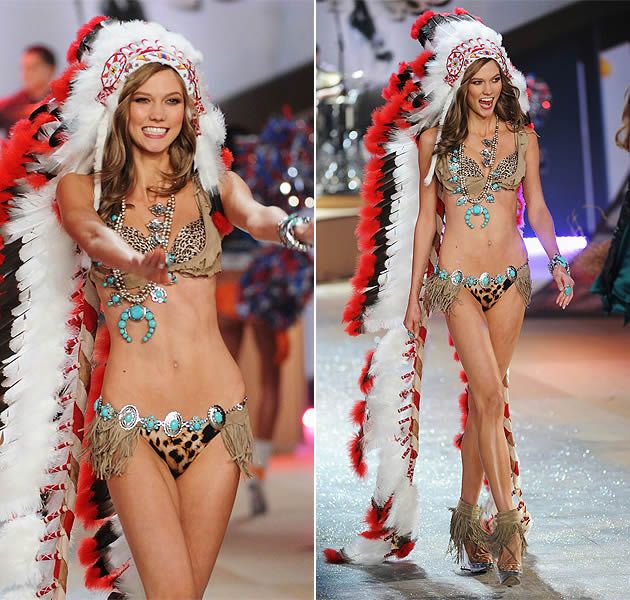So if a Native person tells you that this
is offensive, do you consider them analogous to the child complaining irrationally that the scissors are hurting him?
If your answer is yes, we have nothing else to talk about.
I think the above actual hints towards a pretty central but largely overlooked aspect of this debate, which is the distinction between appropriation and disrespect.
We don't know, simply by observing, the background of the person who designed the outfit. We don't know the background of the model. We would probably assume they're white, and we'd probably be right, but it's
plausible that they're both Native American to some degree or another.
Now, is using a war bonnet as part of a... I'm going to go ahead and guess swimsuit, disrespectful to the traditions of the Plains nations? Evidently, and a Native person is within their rights to be be offended as a consequence. But is it
appropriative? That depends on who's doing it, and we can't simply assume that because it is disrespectful, because it is liable to cause offence, that the person responsible must be from an out-group. There's nothing that says members of the in-group are inherently possessed of the same sense of propriety as any other, let alone an inclination to adhere to that propriety. So, we can't take disrespect, even offense, as evidence of out-group status, and therefore of appropriation. We can make some educated guesses, but we can't assume, and that means we must be looking at two distinct, if frequently-coinciding, phenomena.
Else, we're straying into a creepy sort of ethno-nationalism which holds that there is a Correct way to interact to one's Heritage and that failing to uphold this protocol marks you as either a traitor, impostor or half-breed, and I'd rather leave that sort of thinking for the other side.
But these kind of pseudoscientific theories were not exactly the origins of racism in the 19th century... racism was and is socioeconomic, not cultural. The economic conditions predate the cultural theories.
Well, that's what we're saying. That attempts to rationalise racial categories along physiological lines were overwhelmingly
post hoc, that they describes existing social structures rather than empirical realities, even a mistaken reading of them. As I suggested, the way in which they were drawn up is proof of this: nobody would have spent so much time trying to draw out the fine and largely imaginary gradiations between people on either side of the Elbe or the Irish Sea unless this had some existing political significance.
And material racism has never existed without a physiological marker for its victims. Nobody calls the Holocaust a product of racism, but of Antisemitism, even though the Nazi concepts of the Jew and the Aryan were quite similar to the concepts of “race” like Celt and Alpine.
Racism through the sixteenth to early nineteenth centuries wasn't strongly framed in physiological terms. Physiological differences were noted, certainly, by they weren't given nearly as much weight as would be later on, and were treated as one of an assortment of supposed racial characteristics, usually secondarily to character or psychology.
In the Americas, Europeans spilled gallons of ink on the character of native peoples, on the distinctiveness of their psychology from Europeans, on whether this was innate or environmental, whether they were primitive or just different, but don't often stop to dwell on the colour of the skin or the texture of their hair. Even when describing appearance explicitly, they dwell on costume and ornament and tattooing, and when they talk about physiology, they dwell on the height and health of the Natives, on their muscular physique and proud posture, characteristics which were understood as emphasising the differences in lifestyle and character that the writer was drawing between Natives and Europeans, rather than being particularly significant in and of themselves. If they belatedly remembered to add that they had copper skin or black hair, this wasn't taken to indicate much more than the fact that they lived far away from Europe and close to the equator, which was taken pretty much for granted. It's only in the late nineteenth century that Europeans break out the calipers and start treating these characteristics as the defining terms of Indian-ness, rather than as simple and not even particularly strong characteristics of a much more complex set of categories.
There's an incident in Revolutionary-era Kentucky for which I wish I could remember the citation, it's
somewhere in the Thwaites Collection, were a peace treaty between white settlers and the Shawnee entailed the return of several white captives-slash-adoptees. Among these were two boys who had been taken as infants and raised as Shawnee. They are returned to their birth-father dressed as Indians, speaking as Indians, carrying themselves as Indians, and their father, upon seeing this, drops to his knees, wailing and hollering, "my boys has become Injuns". This is a statement that would make no sense if race was understood in strictly physiological terms, but the meaning of which was immediately understood by the speaker and by the observer, such that the observer didn't feel the need to elaborate on it, all this commentary coming rather two centuries after the fact by modern scholars.
I'm surprised you haven't linked to your favorite picture yet.
View attachment 495200
Y'know, the funniest thing about this image is, what Englishman has
ever looked like that? Like, the "Irish-Iberian" is an unflattering caricature, but it's a caricature of what an Irish person might plausibly look like, while the "Anglo-Teutonic" is a Renaissance painter's idealised face of a Homeric prince.
Which, I suppose, just hammers home the point that they made this stuff up as they go along. The Irish are primitive, so they look like funny peasants. The English are civilised, so they look like Alexander. Nobody has actually bothered to go outside and, like,
check.


